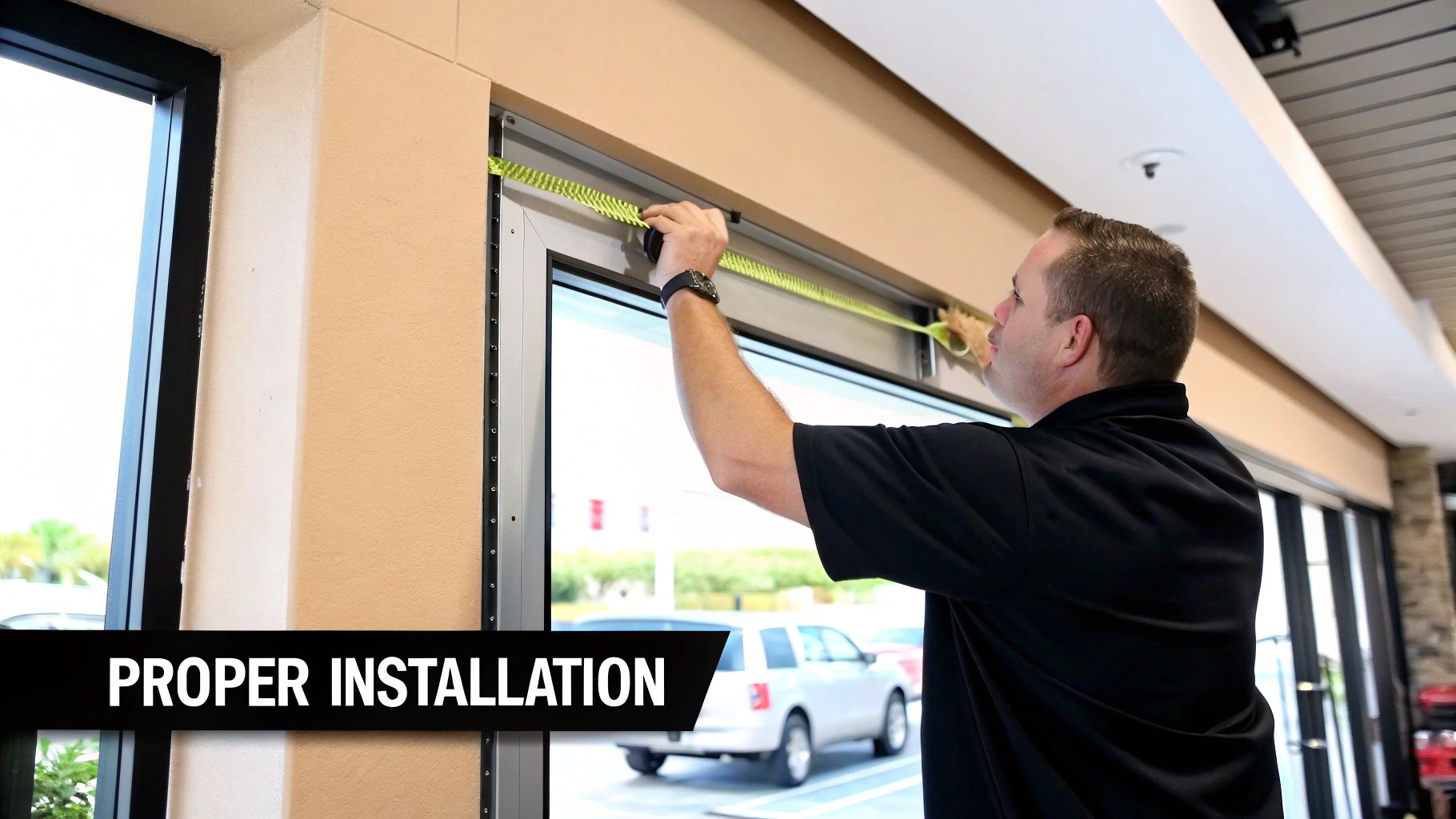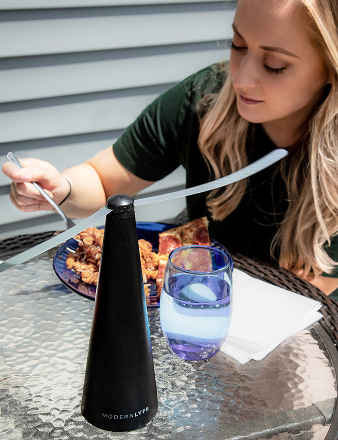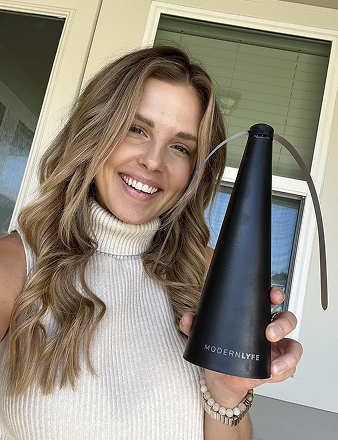Ever notice how a restaurant can keep its doors wide open on a summer day without being swarmed by flies? The secret is often a powerful, invisible force at work right above the entrance: a fly blower, more commonly known as an air curtain.
This smart device creates a high-velocity stream of air that acts as an invisible door. It's the modern solution for keeping the inside in and the outside out, all without a physical barrier.
The Invisible Shield Protecting Your Doorway
Imagine a waterfall cascading over your doorway—but instead of water, it's a sheet of air. That’s the core concept behind a fly blower for doors. It pushes a continuous, downward stream of air across the entire opening, creating a barrier that's surprisingly tough for pests and drafts to penetrate.
This constant airflow separates the indoor and outdoor environments. Unlike a traditional door that's always opening and closing, an air curtain works nonstop, making it a game-changer for high-traffic areas.
- Restaurants and Cafes: Maintain a pest-free dining area while keeping the entrance open and inviting.
- Retail Shops: Encourage customers to walk in while ensuring dust, fumes, and insects don't follow.
- Warehouses and Loading Docks: Protect large, open bays from pests and debris during loading and unloading.
How the Air Barrier Works
The mechanics are simple but highly effective. A fan inside the unit pulls in air from your building, accelerates it, and pushes it out through a narrow nozzle. This forms a uniform "sheet" of air with enough force to literally stop flies in their tracks.
But it does more than just stop bugs. This barrier is strong enough to prevent indoor and outdoor air from mixing. In summer, it keeps your expensive air-conditioned air from spilling out. In winter, it traps heat inside. This keeps everyone comfortable and can lead to serious savings on your energy bills by easing the load on your HVAC system.
Think of it as a bouncer for your building's atmosphere. It guards the door, actively blocking unwanted guests—from flies to drafts—so your indoor climate stays just how you want it: clean, stable, and comfortable.
How Air Curtains Create a Powerful Barrier
A fly blower for your door operates on a straightforward principle, relying on three key parts: a motor, fans, and a specially engineered nozzle. It’s like a finely-tuned wind machine mounted above your entrance. The motor spins the fans, which pull in air from inside your building.
The fans then accelerate that air and blast it through a long, narrow nozzle designed to cover the doorway's entire width. The nozzle’s design is critical—it shapes the fast-moving air into an invisible "curtain" that flows straight down, creating a barrier strong enough to stop flies, dust, and drafts.
The Engineering Behind the Airstream
To generate that powerful, invisible wall of air, these devices use different fan designs. The two you'll encounter most often are centrifugal and tangential fans, each suited for a different job.
- Centrifugal Fans: These are the powerhouses. They pull air in and sling it out at a 90-degree angle, creating a very strong, high-pressure stream. This makes them perfect for busy commercial doorways or industrial settings where you need maximum force.
- Tangential (Cross-Flow) Fans: These look more like long cylinders. Their design produces a wider, more even, and noticeably quieter stream of air. You'll often find these in retail shops or quiet restaurants where minimizing noise is as important as keeping pests out.
This infographic gives a great visual of how one simple device can protect a doorway from multiple problems at once.

As you can see, the air curtain does more than just stop bugs. It acts as a comprehensive shield against airborne annoyances, from dust and pollen to outside fumes.
Making the Air "Stick" to the Doorway
Here's where the science gets interesting. A well-designed fly blower takes advantage of a principle known as the Coandă effect. This is a natural phenomenon where a stream of fluid—in this case, air—tends to hug a nearby surface.
The air shooting from the nozzle "clings" to the wall and doorframe on its way down. This clever physics trick prevents gaps from opening up at the edges of the airstream, ensuring the entire doorway is sealed tight. It’s a big reason why this technology is so effective and its market is growing so quickly. The global market is valued at around USD 1.2 billion and is expected to hit nearly USD 2.3 billion by 2033.
The magic happens when the fan, motor, and nozzle work together, boosted by these aerodynamic principles. It’s what turns a simple blower into a sophisticated environmental separator. You're not just moving air; you're engineering a controlled, invisible shield.
Understanding these technical details helps explain why some models are better for certain jobs than others. To see how this technology compares to other bug-fighting gadgets, read our guide on whether fly fans really work.
How to Choose the Right Fly Blower for Your Door
Picking the right fly blower isn’t as simple as grabbing the first one you see. The biggest mistake is getting the power wrong. Too weak, and you’ll have gaps in your air barrier that pests will find instantly. Too strong, and you’re just wasting energy and creating unnecessary noise.
The goal is to find the sweet spot—the perfect match for your specific doorway and operational needs.
Your first step is simple: grab a tape measure. You need to know the width and height of your doorway. The air curtain you choose must be at least as wide as the door opening, otherwise you're inviting flies and drafts to sneak in around the edges.
Next, consider the mounting height. That stream of air needs to be powerful enough to reach the floor and create a complete seal. If your unit is underpowered for its height, the air current will weaken halfway down, making it almost useless.
Assess Your Environment
What’s happening right outside your door is a huge factor. A shop on a quiet street has completely different needs than a warehouse on a windy plain or a restaurant door fighting pressure changes from the HVAC system.
Strong winds are the natural enemy of an air curtain, pushing against the airstream and creating weak spots. This is why you must think beyond horsepower and consider airflow velocity (how fast the air moves) and airflow volume (how much air is being pushed). A high-velocity stream is essential to cut through external pressures and keep that invisible barrier strong.
A powerful fly blower in a quiet retail boutique might feel like a wind tunnel to customers. Yet, that same unit could be essential for a bustling warehouse loading dock. The key to success is matching the blower's power to the environmental challenges it will face every day.
Match the Blower to Your Business Needs
Beyond the physical specs and local weather, the nature of your business will point you toward the right features. A restaurant focused on a quiet, comfortable ambiance has different priorities than a rugged industrial facility.
To help narrow down the choices, let's look at the main types of air curtains and what they're built for.
Fly Blower Feature Comparison
Each type of fly blower is designed to solve a specific set of problems. This table breaks down the most common options to help you see which one aligns with your business.
| Feature | Ambient Air Curtain | Heated Air Curtain | Industrial Air Curtain |
|---|---|---|---|
| Primary Function | Pest and dust control using unheated, ambient air. | Combines pest control with supplemental heating to improve comfort at the entrance. | High-powered air barrier for large openings, extreme weather, and high-pressure areas. |
| Ideal Environment | Retail stores, restaurants, and commercial spaces in moderate climates. | Businesses in cold climates, customer-facing entrances, and areas needing draft protection. | Warehouses, loading docks, manufacturing plants, and cold storage facilities. |
| Key Benefit | Energy efficiency for pest control without altering indoor temperature. | Enhanced comfort for customers and employees by counteracting cold drafts. | Maximum protection and environmental separation for demanding conditions. |
| Noise Level | Generally low, with models designed for quiet operation. | Varies, but customer-facing models are typically engineered for lower noise. | Can be louder due to powerful motors and high-velocity fans. |
This comparison should make it much easier to align a unit’s strengths with what your business actually needs day-to-day.
For a deeper look into the specific needs of different businesses, our guide on commercial fly fans can provide more insight. By carefully thinking through your door size, external conditions, and business function, you can find a fly blower that delivers a solid return on your investment.
Installing Your Air Curtain for Maximum Effectiveness
You can pick the perfect air curtain, but if it's installed incorrectly, you've wasted your money. It's like buying a top-of-the-line sound system and sticking the speakers in a closet—you won't get the performance you paid for. An improperly installed fly blower for doors creates gaps in the air shield, letting pests and drafts walk right in.

The secret to a great installation is creating a complete, unbroken curtain of air that seals the doorway from top to bottom and side to side. That stream has to be powerful and consistent to do its job.
Perfecting Placement and Angle
First, mount the air curtain as close to the top of the door as possible. The less distance the air has to travel, the more impact it will have when it reaches the floor, creating a formidable barrier.
Just as important, the unit itself must be at least as wide as the doorframe. A shorter unit will leave unprotected gaps on the sides, which is like locking the front door but leaving the windows wide open.
Finally, check the angle. The discharge nozzle shouldn't point straight down. Instead, it needs to be angled slightly outward—usually between 5 and 20 degrees. This angle is your secret weapon against incoming wind and pressure changes, actively pushing back whatever is trying to get in.
The goal isn’t just to blow air down; it’s to create a precisely angled, wall-to-wall air seal. A vertical stream can be easily disrupted, but an angled one creates a resilient barrier that actively deflects incoming forces, from a gust of wind to a persistent fly.
Smart Integration for Peak Efficiency
Why run your air curtain 24/7 when you don't have to? Integrating your fly blower with a door sensor is one of the smartest moves you can make. This setup automatically activates the unit when the door opens and shuts it off when it closes.
This simple connection can slash your energy consumption. Air leaks around doors can account for up to 30% of a building's total energy loss. While specialized blower door tests find these leaks, an air curtain actively seals your biggest entry point.
Hooking up a door sensor doesn't just save money on your electricity bill; it also extends the motor's lifespan by cutting out unnecessary runtime. For any business that wants maximum performance and the best return on investment, it's a must-have. If you're exploring other ways to guard your doorways, our guide on door fans to keep bugs out provides some great alternatives.
Simple Maintenance to Keep Your Fly Blower Running Strong
A fly blower for your door is a workhorse, running all day to keep your space clean and comfortable. Like any hard-working equipment, it needs a little TLC to perform at its best. Simple, regular maintenance is the key to ensuring it runs effectively for years to come.

Think of it like the air filter in your car. A clogged filter makes the engine struggle, hurting performance and burning more fuel. Ignoring basic upkeep on your air curtain leads to the same problems: weaker airflow, higher energy bills, and eventually, a costly breakdown. A few minutes of preventative care each month can save you a massive headache later.
Your Essential Maintenance Checklist
The easiest way to keep your air curtain in peak condition is to stick to a simple routine. This checklist covers the essentials. Remember to always disconnect the power before you start.
- Clean the Intake Grille: This is where your unit breathes. Over time, it will get clogged with dust, grease, and other airborne debris, which chokes the airflow and makes the motor work harder. A quick wipe-down with a damp cloth every few weeks makes a huge difference.
- Inspect and Clean Fan Blades: Pop the cover off and carefully wipe down the fan blades. A thick layer of dust can throw the blades off-balance, leading to vibrations, more noise, and unnecessary wear on the motor.
- Check Electrical Connections: Give the power cord and connections a quick visual check. Look for any obvious signs of damage or fraying that could become a safety hazard.
- Clear the Area: Ensure boxes, signs, or decorations aren't blocking the air intake or the outlet nozzle. The invisible air barrier needs a clear path to work properly.
Following these steps does more than just extend the life of your fly blower—it ensures the airstream stays powerful enough to do its job. It’s a small investment of time for a big return.
Quick Troubleshooting for Common Issues
Even a well-maintained machine can have an off day. Before you call a technician, many common problems have a simple DIY fix.
An odd noise or a sudden drop in airflow is your air curtain’s way of asking for help. Catching these small signals early can stop them from turning into big, expensive repairs.
Here’s a quick guide to diagnose and fix common issues.
Problem 1: The Airflow Feels Weak or Uneven
- The Usual Suspect: A clogged intake grille is the culprit 9 times out of 10. If the unit can't pull in enough air, it can't push enough out.
- The Fix: Turn off the power and give the intake grille and filter (if it has one) a thorough cleaning. You'll be amazed at the power you get back.
Problem 2: The Unit is Making a New, Strange Noise
- The Usual Suspect: A new rattling or buzzing sound usually means a casing screw has vibrated loose, or a small piece of debris got sucked into the fan housing.
- The Fix: With the power off, double-check that all external screws are snug. Then, look inside the fan area for any stray objects and carefully remove them.
By staying on top of basic maintenance and troubleshooting, you can ensure your fly blower for doors remains a reliable, powerful, and quiet part of your business.
More Than Just Flies: The Full Value of an Air Curtain
While "fly blower" is a descriptive name, it sells these devices short. Thinking of them as just bug zappers for your doorway is like calling a smartphone a calculator—it misses the bigger picture. The real value isn't just in pest control; it's in what they do for your energy bills, customer comfort, and daily operations.
Let's start with the biggest benefit: energy savings. Every time your door opens, your expensive heated or cooled air rushes out. This constant exchange puts a massive strain on your HVAC system, forcing it to work overtime to keep the temperature stable. An air curtain creates an invisible barrier that stops this exchange cold, dramatically reducing your HVAC workload and saving you money.
Installing a fly blower isn't about adding another gadget. It's about making your building smarter. You're sealing the biggest point of energy loss—the doorway—without actually closing the door to business.
A Better Experience and Cleaner Air
Beyond the bottom line, an air curtain makes your space more pleasant. No one likes a blast of hot or cold air when they walk in the door. An air curtain eliminates those uncomfortable drafts, keeping both customers and staff happier. It's a subtle touch that makes a big difference in the overall experience.
They also act as a gatekeeper for your indoor air quality. That powerful stream of air doesn't just stop bugs; it also helps block other unwanted airborne particles like dust, pollen, and car fumes. In this way, they support a cleaner environment, much like dedicated air purification systems do for indoor spaces.
Boosting Safety and Hygiene
The benefits even extend to safety, especially for businesses with specialized areas like walk-in freezers. When the freezer door opens, warm, humid air rushes in, instantly creating fog and icy buildup on floors. An air curtain stops this from happening, reducing the risk of slips and falls and preventing damaging frost on your equipment.
This growing focus on creating healthier, more convenient indoor environments is part of a larger trend, with increasing demand for smart solutions like pleated fly screens. You can learn more about pleated fly screen market trends to see how this is playing out. When you see an air curtain as a multi-purpose business tool, you unlock its potential to make your business safer, more efficient, and more comfortable.
Got Questions About Fly Blowers? We've Got Answers
Even after you understand how these "invisible doors" work, a few practical questions usually pop up. Let's tackle the most common ones so you can feel confident in picking the right unit.
What's This Going to Do to My Electric Bill?
That's a fair question, and the answer depends on the model's size, power, and whether you choose a heated version. A standard, non-heated commercial unit typically uses between 0.5 and 2 kilowatts per hour.
The secret to keeping costs low is smart operation. Look for models with variable speed motors and, most importantly, connect them to a door sensor. This simple setup is a game-changer, ensuring the air curtain only runs when the door is open. This can cut energy use by up to 80% compared to letting it run all day.
Just How Loud Are These Things?
Nobody wants to trade a fly problem for a noise problem. Thankfully, modern air curtains are engineered to be quiet.
Most units operate at a sound level between 50 and 65 decibels (dB). To put that in perspective, it's about the same volume as a normal conversation or a dishwasher.
If you run a quiet restaurant or a high-end boutique where ambiance is everything, you can find models specifically marketed as "low-noise." Units that use tangential fans are also known for producing a softer, less disruptive sound.
One quick but important note: An air curtain is a partner to your HVAC system, not a replacement. It’s brilliant at keeping your conditioned air in, but it doesn't create cold or hot air on its own (unless it's a heated model).
While a heated fly blower can provide a welcome blast of warmth on a chilly day, it's not meant to be the main heat source for your building. Think of it as a bouncer for your doorway, protecting the comfortable climate you've already created inside.
Ready to create an invisible shield for your doorway? The innovative fly fans from MODERN LYFE offer a stylish and effective way to protect your space. Explore our collection and find the perfect solution for your needs at modernlyfe.com.






